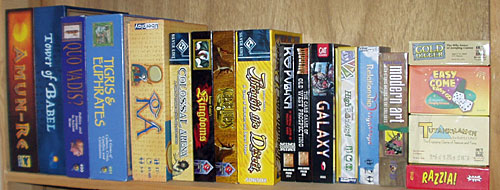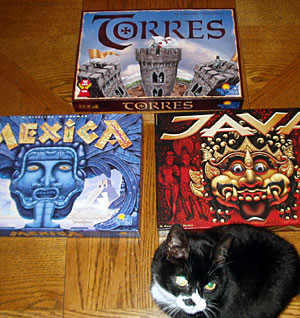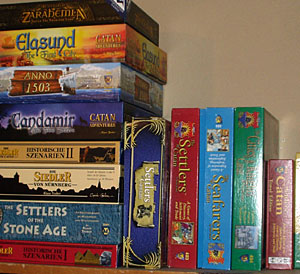 I like puzzles. No, not necessarily the sort that you'd fine in Games magazine, but instead puzzles where you slowly build up pieces of information, only to see a larger pattern suddenly emerge. Tactical games often satisfy this desire in me, be it Australia or Dungeon Twister, because you can imagine the chaos of possible turn, but then a sudden, perfect move abruptly emerges. I suspect Sleuth would satisfy this urge too, and I have no idea why I don't own a copy of that yet.
I like puzzles. No, not necessarily the sort that you'd fine in Games magazine, but instead puzzles where you slowly build up pieces of information, only to see a larger pattern suddenly emerge. Tactical games often satisfy this desire in me, be it Australia or Dungeon Twister, because you can imagine the chaos of possible turn, but then a sudden, perfect move abruptly emerges. I suspect Sleuth would satisfy this urge too, and I have no idea why I don't own a copy of that yet.This like also influences my writing, and so I often have a desire to categorize, index, and sort, hoping to again find that ever-elusive pattern underlying the mundane. And that's what I'm going to do this week, in the first of what I expect will be many columns about game designers.
Here I'm going to give overviews of three of my favorites, and talk a little bit about what I feel holds their games together. The three designers I've choosen for this installment are, I think, the three biggest influences on the current Eurogaming scene: Reiner Knizia, Wolfgang Kramer, and Klaus Teuber--the Special K's, to quote another website.
#1: Reiner Knizia
Reiner Knizia is, in my mind, the father of the modern Eurogames movement. Sure, it was Teuber that broke the field wide open, but Knizia really seems to have envisioned the lightly themed, heavily mechanical style of play which is emulated by most modern German designers.

In general, I'd call Knizia the "elegant designer". He has a superb ability to create simple mechanics that allow for deep and meaningful strategy & tactics. In addition he seems to be a superb developer, producing games that are well-considered, without sharp edges, and largely picture perfect. Some Knizia games aren't to my liking, but it's rare that I see a Knizia game that has an actual flaw in it (though some do; no one's perfect).
The biggest problem with Knizia's designs is that he produces a wide variety of games, from ultra-ultra-light to medium-heavy, and they're for a wide variety of audiences. A lot of people seem to be expecting him to put out a certain type of design (usually, one of those medium-heavy games), and so they're disappointed by everything else. This year Knizia put out at least three games that I think will be enjoyed by gamers for years to come, two medium-light designs, Tower of Babel and Palazzo, and one medium design, Beowulf: The Legend, and they were mostly met with undeserved scorn and derision. Buck up, folks, not everything is going to be Tigris & Euphrates or Through the Desert.
I'd further classify Knizia's games by saying that they're almost all "auction games". By this I mean that you offer up scant resources in opposition to other players for the chance of winning some prize. You have what used to be his "auction trilogy", now including High Society, Medici, Modern Art, Ra, Traumfabrik, Amun-Re, Taj Mahal, The Merchants of Amsterdam, Palazzo, and Beowulf. You also have closely related trading games, such as Res Publica and Tower of Babel, differentiated mainly by the fact that the auctioneer isn't required to take the "best" bid. His bidding games, like Titan: The Arena and Goldrush are similar, except the items you have to "bid" are much more random. Even two of his very popular "tile-laying games", Samurai and Tigris & Euphrates, shade into the same categorization, since your have various values of certain currencies (a 3 buddha, 5 temples) which allow you win certain prizes (a city, a civilization). I'll grant that the last one is starting to stretch the definition, but the mathematical maximization is still there, and perhaps that's not a surprise given Knizia's mathematical background.
Perhaps the only top Knizia game that doesn't seem to fit into this style of play is Through the Desert, which places more importance on board position and majority control than just about anything else Knizia has done. (Well, actually, Carcassonne: The Castle and Tigris & Euphrates place a huge importance on board position, while Tower of Babel is a rare majority-control game for Knizia, but for someone with this many games, there's going to be exceptions to everything.)
My Reviews1: Through the Desert (A), Taj Mahal (A), Ra (A), Amun-Re (A), Tigris & Euphrates (A), Modern Art (A-), Carcassonne: The Castle (A-), Lost Cities (A-), Razzia (A-), Beowulf: The Legend (B+), Samurai (B+), Blue Moon (B+), Lord of the Rings (B+), Easy Come, Easy Go (B+), Titan: The Arena (B+), Tower of Babel (B), Palazzo (B), Quo Vadis? (B), High Society (B), Buy Low, Sell High (B), Relationship Tightrope (B-), Poison (C+), Tutankhamen (C+),Gold Digger (C+), Res Publica (C), Galaxy: The Dark Ages (C), Kingdoms (C), Spy (C),Loco! (D+)
Interviews: Funagain (1999), Gamefest, on Einfach Genial (2004), BGG podcast (2005)
#2: Wolfgang Kramer
If Reiner Knizia is the father of the Eurogames movement, Wolfgang Kramer is its grandfather. He's been publishing games since 1974 and some of his games are utterly foundational. Kramer usually designs his games with other people, Michael Kiesling being his most frequent, and I think most successful, goto guy, but I'm not going to try and differentiate. All of Kramer's collaborations are fair game here (and in other similar articles I plan to write).
 At heart I'd call Kramer a "tough designer". Most of his games have a diamond heart. They require deep strategy or very thoughtful tactics in order to succeed. He's done some light and fluffy stuff, but they're either less-common or less-well-known than Knizia's, and Sunken City is the only game I can think of that really disappointed people solely because it was too light.
At heart I'd call Kramer a "tough designer". Most of his games have a diamond heart. They require deep strategy or very thoughtful tactics in order to succeed. He's done some light and fluffy stuff, but they're either less-common or less-well-known than Knizia's, and Sunken City is the only game I can think of that really disappointed people solely because it was too light.Kramer shows a lot of versatility & originality as a designer, and this makes some of his games, as already noted, foundational. El Grande kicked off a whole genre of majority-control games (though some are arguably the result of Sackson's Acquire instead). 6 Nimmt! no doubt influenced later simultaneous-play card games. Heimlich & Company could easily have been Clans' predecessor. Other top-level games that show Kramer's versatility but haven't necessarily had the same effect on the industry include El Caballero (tile-laying), Pueblo (spatial geometry), Goldland (exploration), Daytona 500 (racing), and of course Princes of Florence (auction).
However Kramer's biggest category of games are "tactical games". These are largely action-point-based systems which fit my core definition of a "puzzle game". They allow players many opportunities to try and figure out how to do clever things on a turn-by-turn basis with limited resources. Entrants include Tikal, Torres, Java, Mexica, Maharaja, and Australia. These are all inevitably collaborations with Kiesling.
For some reason I haven't actually reviewed many of Kramer's games, though he's one of my current favorites, as evidenced by his inclusion here.
My Reviews1: El Grande (A), Torres (A), Maharaja (B+), Java (B+), Mexica (B+), The Princes of Florence (B), Saga (B), Category 5 (B-), Sunken City (B-)
Interviews: Games International (1990), Game in the Box (2001), Gamewire (2004), Interviews by an Optimist (2005)
#3: Klaus Teuber
Finally we come to Klaus Teuber, Eurogaming's kindly uncle. His games are very approachable, but surprisingly are outside of the norm for German games. Where most German games are lightly themed, his aren't, and where many try and reduce randomness, Teuber happily uses dice. In many ways Teuber's games are closer to modern French designs than German ones (a topic I'll get back to next week). Nonetheless a lot of the success of Eurogames, both in Germany and in the United States, is due to the singular influence of The Settlers of Catan.
 For that reason, Teuber is inevitably the "Catan designer". Catan makes up at least half of Teuber's output, and definitely most of his better known games. Besides the core game, and the Seafarers and Cities & Knights supplements we also have historical scenarios, licensed versions, and more recently full variants like The Settlers of the Stone Age and The Starfarers of Catan. Most recently Teuber has stepped away from whole-blown Catan system, but he continues to use the same basic idea: randomly produce resources, manage them, and build new stuff with them. Anno 1503, Candamir, and Elasund all fall into this later design period. A more general way to describe most of Teuber's output is "resource management games" but that's really just code for Catan.
For that reason, Teuber is inevitably the "Catan designer". Catan makes up at least half of Teuber's output, and definitely most of his better known games. Besides the core game, and the Seafarers and Cities & Knights supplements we also have historical scenarios, licensed versions, and more recently full variants like The Settlers of the Stone Age and The Starfarers of Catan. Most recently Teuber has stepped away from whole-blown Catan system, but he continues to use the same basic idea: randomly produce resources, manage them, and build new stuff with them. Anno 1503, Candamir, and Elasund all fall into this later design period. A more general way to describe most of Teuber's output is "resource management games" but that's really just code for Catan.A few of Teuber's older designs including Barbarossa and Hoity Toity have been reprinted recently. They're a bit old and creaky, and as far from the German norm as Catan, but still quite good games. Oddly enough his two other hit games were originally meant to be part of a mega-Catan game. The game that became Entdecker would have showed the settling of the island, The Settlers of Catan its development, and then Domaine the warfare that followed. Entdecker and Domaine, however, are totally distinct from Catan-like mechanics, and in fact are each quite stand-out games in their genres (exploration and warfare) and I personally think they outshine the more popular Settlers.
Reviews1: The Settlers of Nurnberg (A), Entdecker (A), Domaine (B+), Elasund: The First City (B+), Barbarossa (B+), The Settlers of Zarahemla (B+), The Kids of Catan (B+), The Settlers of Catan (B), The Settlers of Canaan (B), Anno 1503 (B), Hoity Toity (B), Starship Catan (B), The Seafarers of Catan (B-), Candamir: The First Settlers (B-), The Settlers of the Stone Age (B-), The Cities & Knights of Catan (B-), The Settlers of Catan Historical Scenarios I (B-), The Starfarers of Catan (C+), Oceania (C+), The Settlers of Catan Card Game (C+)
Interviews: Gamewire (2004), Catan Online (2005)
1. Review Links. A few caveats on these rating links: note that my letter grade incorporates both the components and the gameplay, though at an approximate 1:2 ratio. Also note that it's hard to keep this sort of rating accurate over years of reviews, so the resultant rankings may not be 100% accurate, though I've tried my best (and indeed have gone back and revised a few reviews once I saw everything together for this article). In addition, these listings don't try and be complete; they're a combination of my actual reviews, plus a few ratings I felt comfortable throwing out for stuff I've played but haven't reviewed (yet).
6 comments:
I still find it hard to believe that you rate Loco! (aka Quandary) so low. Yes, the game is dirt simple -- place a marker, take a stock -- but the bluffing and counter-thinking makes this game a lot of fun and well worth repeat plays. Playing multiple rounds pushes you to suss out what the other players are aiming for, and how you can turn their actions to your benefit.
"I'd call Knizia the "elegant designer". He has a superb ability to create simple mechanics that allow for deep and meaningful strategy & tactics".
Hmmm, Amun Re, Tigris, simple mechanics?
I think Throught the desert is simple and elegant and Ra simple and boring.
On Loco!: As I said in my review, I think that the chaos of the card placement is so high that it totally destroys any possibility for strategy. It's similar to my complaint about the worker placement in _Keythedral_.
I gave the game 4 tries, which I think is more than enough for a game of this weight.
On Simple Mechanics: Yes, I entirely think that Tigris has simple mechanics. It's a straight up auction in a specific color, with you trying to overcome the strength of the opponent. I will grant one point of complexity: each color has a special rule (black = lets you gather any points; blue = placement restrictions; red = helps leaders; green = collects treasure chests), and that's pretty unusual for Knizia.
As for Amun-Re, I'd agree those aren't particularly simple mechanics. There's a lot of complexity between all the different phases of the game and all the action cards and the different sorts of auctions. I think in many ways it's a fairly unusual game for Knizia.
Shannon wrote: "As I said in my review, I think that the chaos of the card placement is so high that it totally destroys any possibility for strategy."
The same person always does extremely well in the games I've played, never finishing below second in four-player games, so I would never have thought of the card placement as chaotic. (This person is not me.)
Each marker you hold is a stock that's going to be worth 0-5 points at the end of the round. Based on the tiles (cards) you hold, you have some knowledge of which stocks you can sink, which you can float, and which are unknown.
As the tiles come out, the possible values of each stock shrink, giving you more information on how the remainder of the round might unfold.
You might not have found the magic in this game, but I think Quandary is the essence of Knizia's elegance.
I think of Flinke Pinke (Loco) as the foundation for the Grand National Derby/Titan: The Arena/Galaxy lineage of games (which you rate somewhat higher). It's the same mechanism (playing cards and taking shares/bets), except instead of one suit being eliminated each round, there's only one round and the relative values of the suits matter. But since the entire deck (almost) is dealt out at the beginning, instead of cards being drawn every turn, you can do some bridge-like deduction over the course of the round to figure out what people have in their hands.
Nice article, Shannon, but then I guess I'm partial to things written about these three particular designers! :-)
I don't grok the Knizia/auction connection, but it seems your definition of "auction games" is very different from mine. Yours is so broad that it seems that *most* games could be classified as auction games, whether by Knizia or any other designer. As for the "elegant designer" comment, I agree that many of Knizia's designs feature a simple idea expertly developed, but I also agree with Mario that several of his games are quite complex.
Are Kramer's games tough? Well, many of his later ones are, but prior to El Grande, his games were almost exclusively aimed at families. They were very *good* family games, but they certainly wouldn't fit the description of "tough". They also include some very well known games (Heimlich & Co., 6 Nimmt!, Wildlife Adventure, Big Boss, etc.). For a while, the only Kramer gamer's games came in collaborations, but recently, he's released some challenging solo designs, like Wildlife, Goldland, and Hacienda. But even in his more recent fare, Kramer produces games for every age and taste, much like Knizia does, including medium and lightweight fare like Australia and Verflixxt. He's very capable of creating some very challenging games, but so is Knizia, as well as Wallace, Dorn, Friese, and others.
Post a Comment